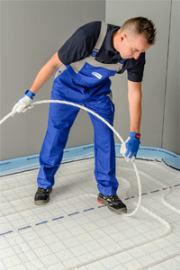Underfloor Heating (UFH) has been installed in British homes for decades yet its roots go back 100’s of years. In fact its true heritage lies in the Roman times. Despite its rich heritage, there remains some confusion in the market place around some aspects of the technology and its suitability to the UK climate.
 Underfloor Heating (UFH) has been installed in British homes for decades yet its roots go back 100’s of years. In fact its true heritage lies in the Roman times. Despite its rich heritage, there remains some confusion in the market place around some aspects of the technology and its suitability to the UK climate.
Underfloor Heating (UFH) has been installed in British homes for decades yet its roots go back 100’s of years. In fact its true heritage lies in the Roman times. Despite its rich heritage, there remains some confusion in the market place around some aspects of the technology and its suitability to the UK climate.
Here Neil Young, Indoor Climate Applications Manager at Uponor UK, talks through the top UFH questions and sets the record straight.
1. Can you use UFH beneath carpet?
To get the best out of your UFH system, it’s important to remember resistance values in order to get the greatest benefit from the installation. We would advise a maximum TOG rating for underlay of 1.0 and carpet 1.5 when planning the floor covering.
2. Can I install UFH beneath ceramic tiles or timber floor coverings?
Ceramic tiles are actually the best floor covering for UFH, as the material is a natural convector of heat.
If you are installing a timber floor covering however, we would advise always checking with the floor manufacturer what the maximum floor surface temperature is; to ensure that it is suitable. One simple addition could be the introduction of a floor sensor to ensure the maximum temperature is not exceeded.
3. What can I do to prevent UFH pipes freezing during the winter?
During installation you can actually add anti-freeze into the pipework but remember to flush this from the system before commissioning. Once operational, there should not really be a risk of freezing pipes as UFH should be kept at a low surface temperature, at all times.
4. Why should an UFH system be kept on all the time?
Unlike radiators, UFH takes a little time to heat up. Radiators operate through a process of convection - warming the air immediately around them and then distributing it around the rest of the room. UFH operates slightly differently; heating a larger surface (with low temperature water) – creating ‘radiant heat’, a comfortable and consistent temperature throughout the room and preventing any cold spots.
5. Is it true that UFH is only suitable for new builds?
New build properties have the benefit of being built to high air tightness standards which means two things; minimal heat leaks out and very little cold air gets in. Despite this, older properties can still benefit from UFH but the energy efficiency returns will be a little less than a system installed in high efficiency home.
6. What is the most suitable location for the manifold?
Ideally the manifold should be located in a central place to ensure minimal pipework runs. This may be the airing cupboard, the downstairs closet or even the garage; whichever is the most central.
7. What is the best heating source to combine with UFH?
You can combine UFH with a variety of heating sources as long as suitable controls are fitted to regulate the temperature flow. As UFH operates at a much lower temperature than a traditional wet system, featuring radiators, it’s important to bear this in mind during specification.
UFH will work with a variety of heat sources and is ideal when partnered with low carbon solutions such as ground or air source heat pumps, as the low water temperatures will result in the greatest performance from the heat pump.
8. How can you be sure that the UFH system is the correct size?
Just as radiator systems are sized on the BTU or K/w, UFH is specified based on the heat loss potential through the walls, windows and flooring. The calculations are widely available on the internet but if in doubt, please call the Uponor customer service team.
When it comes to any heating system installation, preparation and planning is critical. From the location of the manifold through to the type of flooring installed; each and every factor should be considered at the point of specification and relevant information passed to the building owner to help them in the decision making process.
Needless to say, UFH is a leading technology within the built environment but knowledge and awareness of the technology remains low. With further advancements in low carbon technologies and as the home improvement market continues to grow, UFH is likely to increase in popularity too. Now is the time to build knowledge and an understanding of the technology in order to reap the long term benefits.
Uponor www.uponor.co.uk, email enquiries.uk@uponor.com or call 01455 550355.